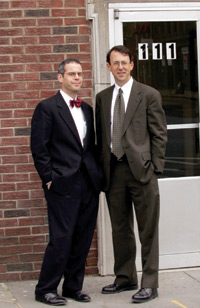|
|
 |
 |
 |
 |
|
FIRST PERSONReuniting To Build Better HousingBy Michael Skrebutenas ’86
Nearly 20 years after becoming friends at Columbia, Chris Betts ’84 and I not only have ended up in the same profession of community development but also work together on housing projects. We recently completed a major phase of a joint venture on a housing development for the homeless in Newburgh, N.Y., and we plan to collaborate on many more projects. Our interest in community and housing development probably started in 1984 while living at River Hall on 114th Street between Broadway and Riverside. River was the bottom of Columbia’s residential barrel. I am convinced that I lived in the smallest room in the system, facing an air shaft to boot. Chris’ room in River was three times the size of mine. I’m not sure if I really liked his company, or if I was claustrophobic and liked his room. Despite this less than auspicious start, we’ve been great friends since; we drank at Cannon’s, traveled together and celebrated each other’s weddings. Twenty years ago, New York City, and specifically the Upper West Side, was a harsher, grittier place — not a Starbucks or a sidewalk café to be found. Inner city urban disinvestment had reached its height, and homelessness was a growing phenomenon. I recall seeing my first homeless man hollering at the world on the corner of 114th and Broadway. Chris was from upstate and I was a smalltown kid, so this didn’t sit well with us. The disconnect between our comfortable dorm rooms (even River!) at CC and this poor soul on the corner was too challenging for us to forget. After graduation, I earned a law degree from the University of Connecticut and quickly became disenchanted with law practice. In my short career in municipal law, I spent a lot of time protecting areas of Connecticut from affordable housing development. The intent of many of these communities seemed to be clear — they wanted to block the poor and minorities from reaching their borders. I went back to Columbia and received an urban planning degree from the School of Architecture in 1995, with the vague notion that I wanted to build affordable housing. Meanwhile, Chris and his wife, Diane Wheatley ’83 Barnard, moved to Philadelphia, where he joined Mayor Ed Rendell’s administration. Chris was working to develop affordable housing and revitalize neighborhoods with the Friends Rehabilitation Program, a Philadelphia community development corporation. Fifteen years ago, Philadelphia’s blighted neighborhoods were overwhelming — miles upon miles of abandoned housing, factories and commercial strips. Chris was making great progress working on a number of projects in North and West Philadelphia, helping to turn his organization into an important catalyst for neighborhood transformation. Beginning in 1991, Chris immersed himself in urban affairs, working at a community development corporation while earning a master’s degree from Penn’s Fels Center of Government. We found ourselves on parallel tracks as early as 1989; I had begun working in New York City government — the Financial Services Corporation (now Economic Development Corporation) — and we both were active in city Democratic Party organizations. When Chris finished his master’s and began working in community development, an emerging field at the time, he took me with him. We immediately saw the field’s appeal, because it merged politics, law, finance, planning and architecture; community development is the art of the possible. While Chris began working for Friends Rehabilitation Program, I did similar work for The Community Builders in New Haven, Conn. In 2000, Chris, his wife and their three boys moved from Philadelphia to Albany, N.Y., and he accepted a position with a nonprofit housing developer. In 2002, I started working at Common Ground, a developer of permanent housing for the homeless headquartered in New York City. When I was charged with the responsibility of financing and building a project in Newburgh, N.Y., I decided to partner with Chris, who was now with Community Preservation Corp., a New York City-based nonprofit financing institution. Our plan was to rehabilitate a 128-unit former hotel in Newburgh into permanent, supportive housing for the homeless. Supportive housing merges affordable housing with social services, to assist residents who struggle with addiction, mental illness or unemployment. The work, which began in 2002 and will be completed in 2006, includes rebuilding storefront spaces in an attempt to bring life back to downtown Newburgh. Unfortunately, Newburgh typifies many of the challenges faced by older U.S. cities. Years of neglect and fundamental shifts in regional economies have diminished the power of centered-place economics. The greatest gift I received from Columbia, besides friendship, was an appreciation of urban form and a sense that urbanity was worth fighting for. While in college, Chris and I shed enough of our small-town ways to enjoy the pleasure of sushi, theatre and museums; we picked up all the affects of New York living and take them with us today. We do, however, cherish opportunities to escape the pressures of our inner city work, usually on backpacking trips or working together on the Upstate New York farm of Chris’s father, George Betts ’57. As an adjunct faculty member at the School of Architecture, Planning
and Preservation, I teach two courses, “Affordable Housing
Development” and “Real Estate Finance.” Chris
will teach “Managing Community Development” this spring
at the School of Urban Planning. Michael Skrebutenas ’86, ’95 AR, director of replication for Common Ground Community, lives in New Haven, Conn., with his wife, Anne, and daughters, Lucy and Caroline.
|
|
|||||||||||||||||||||||||||||||||||||||||||||||||||||||||
